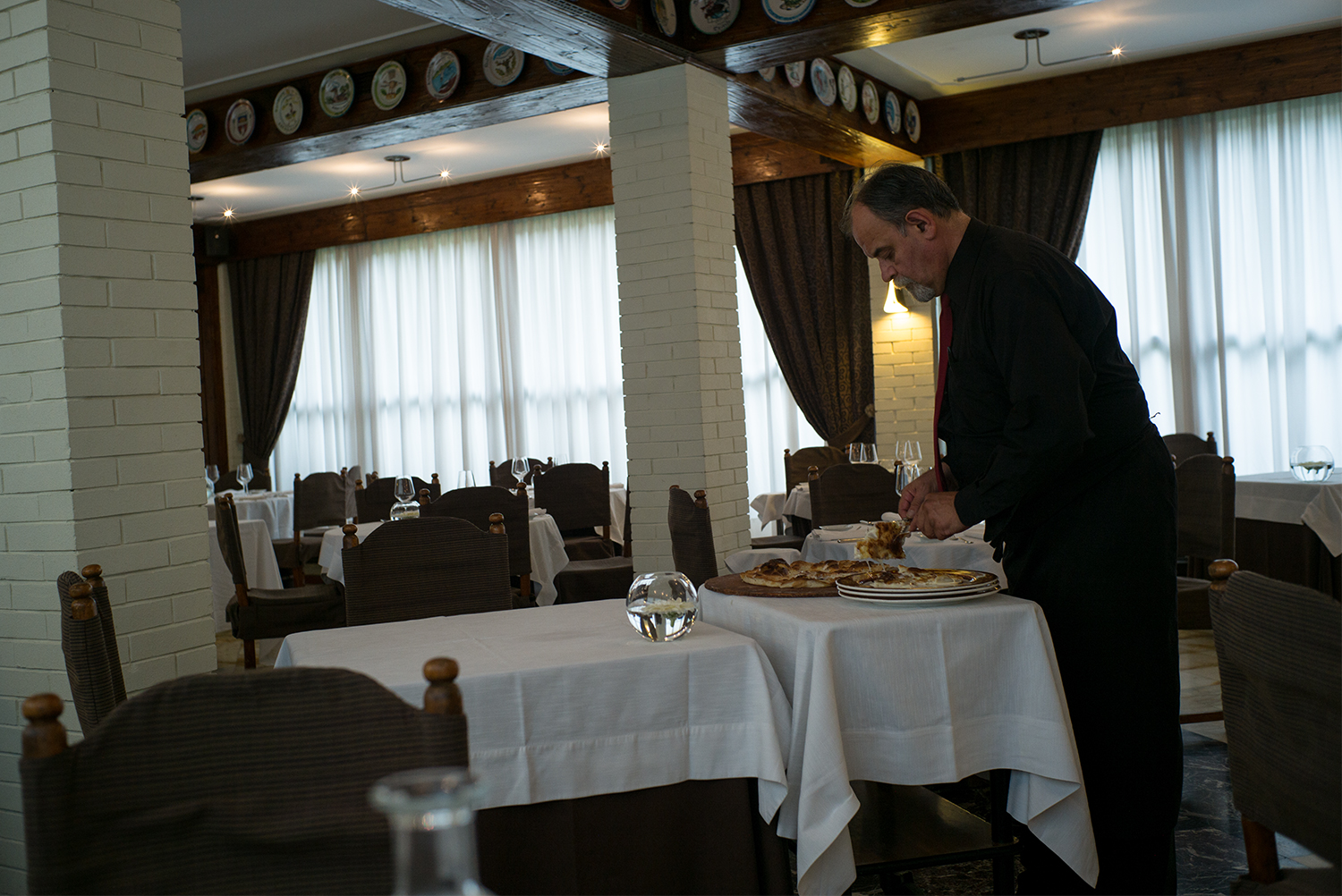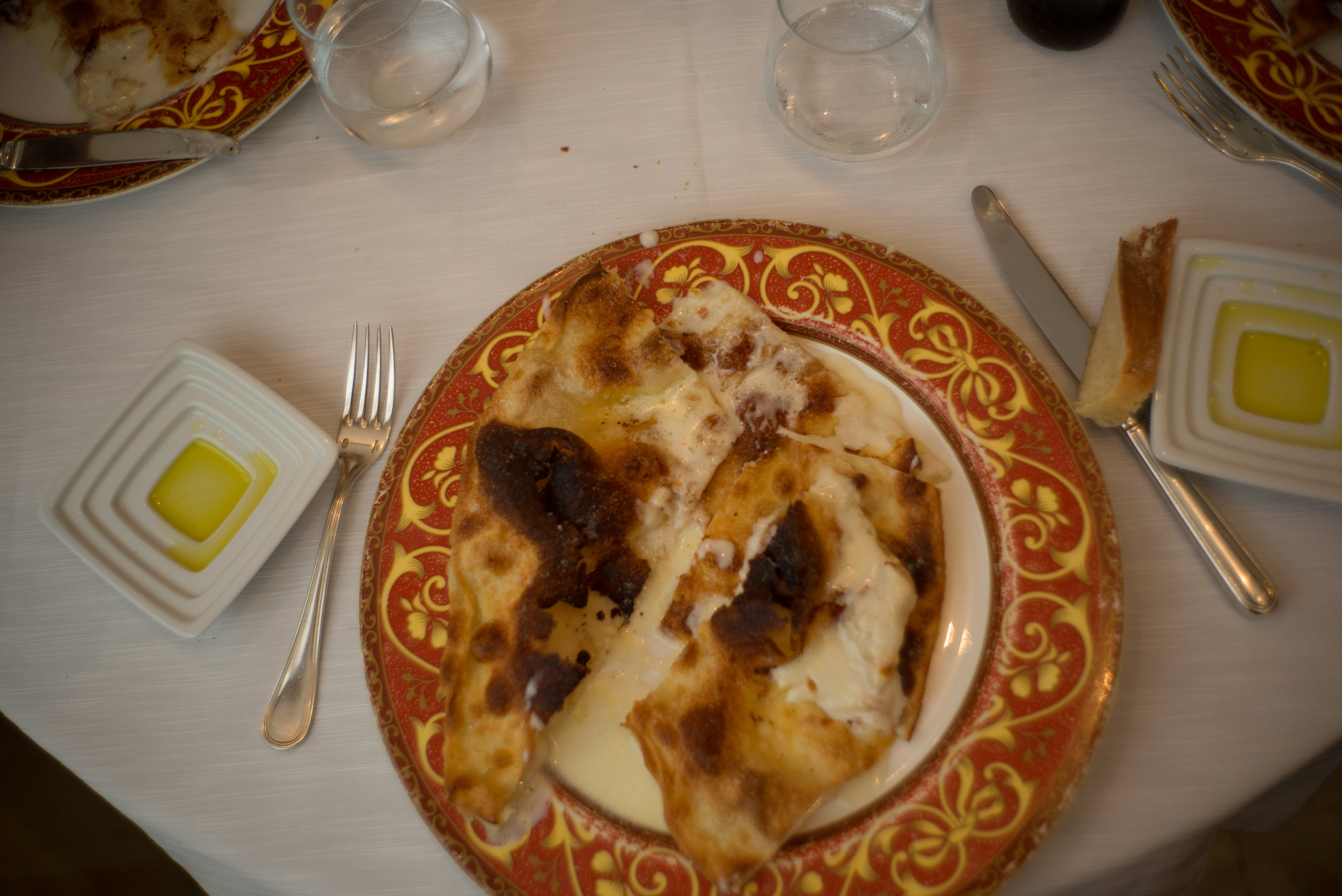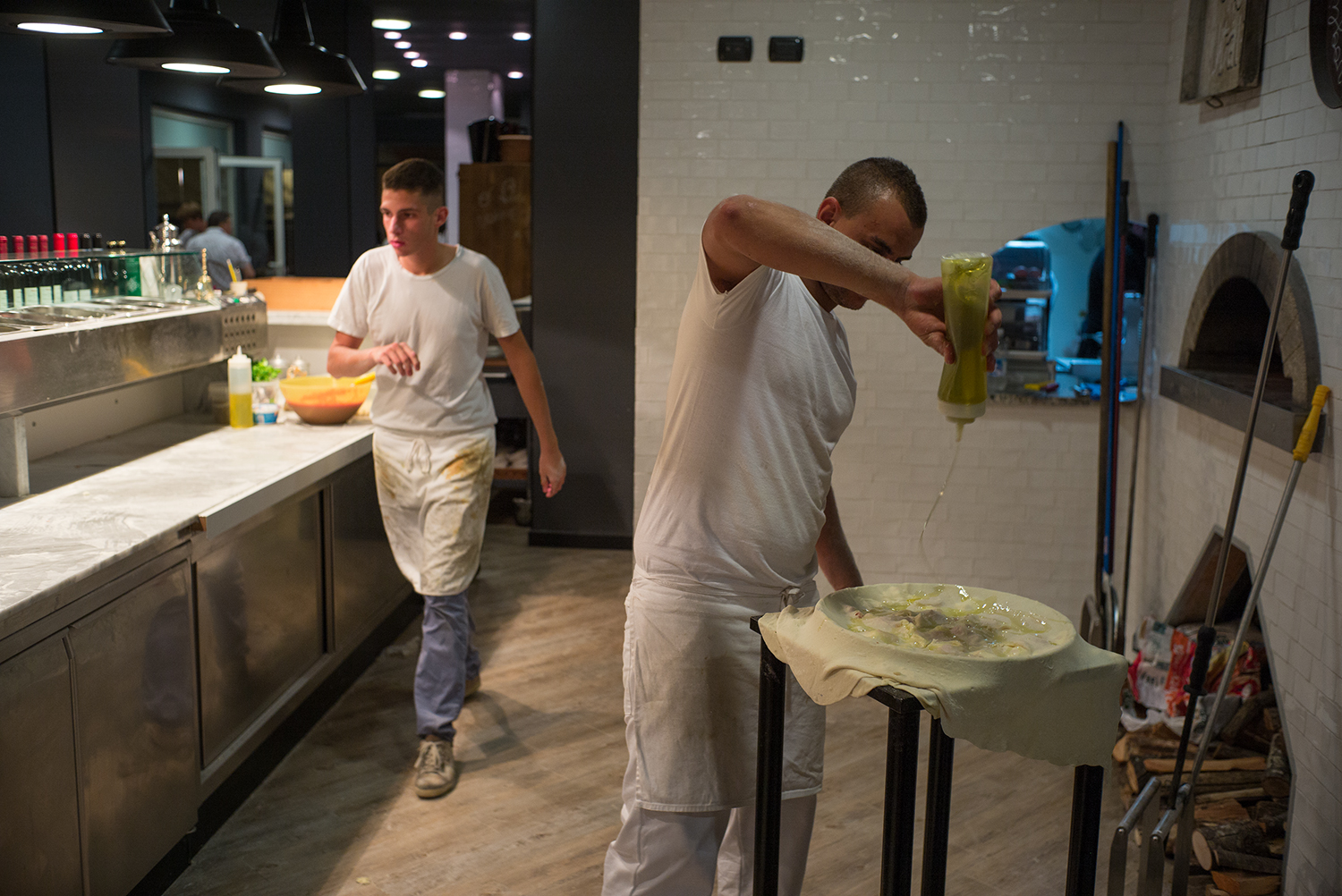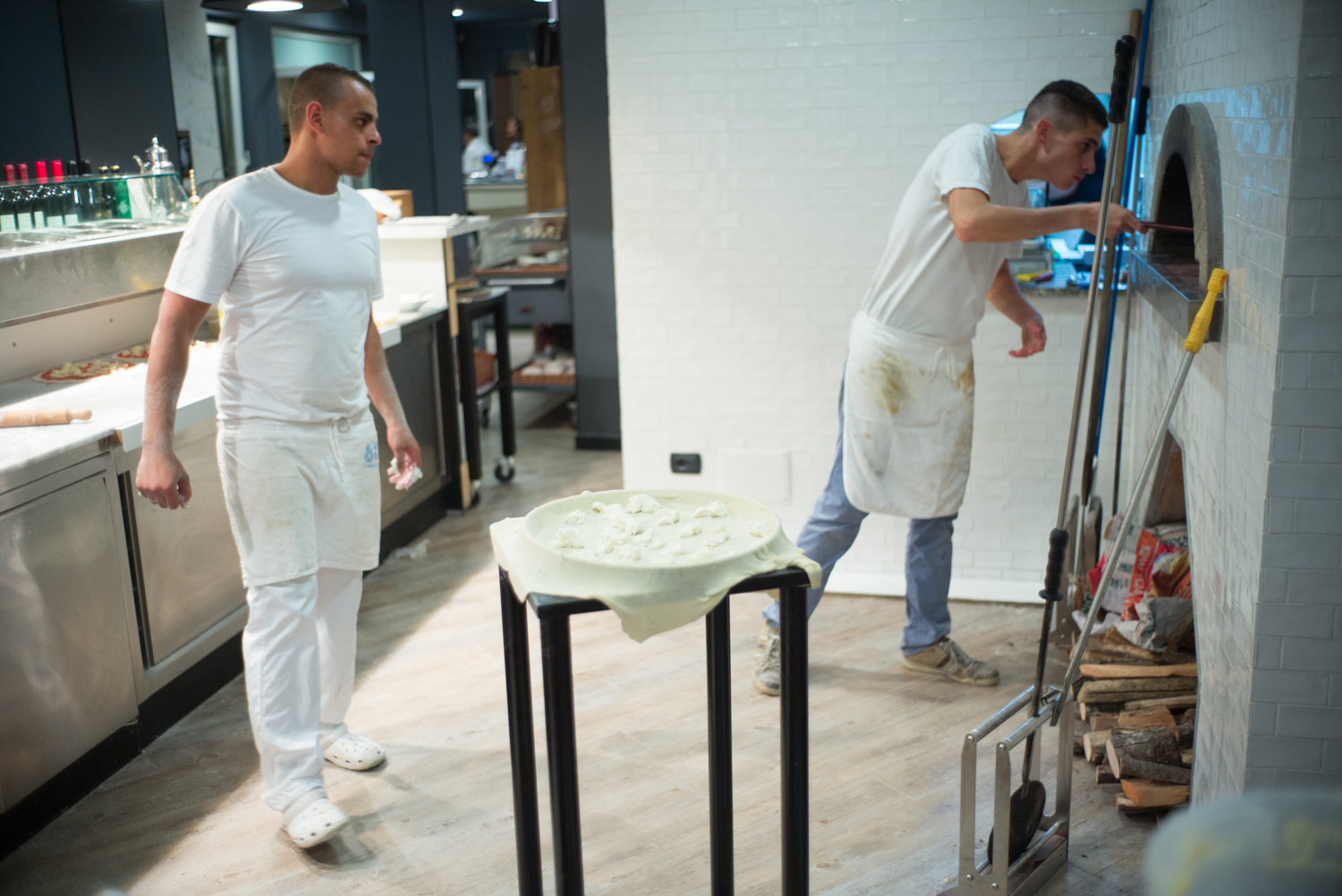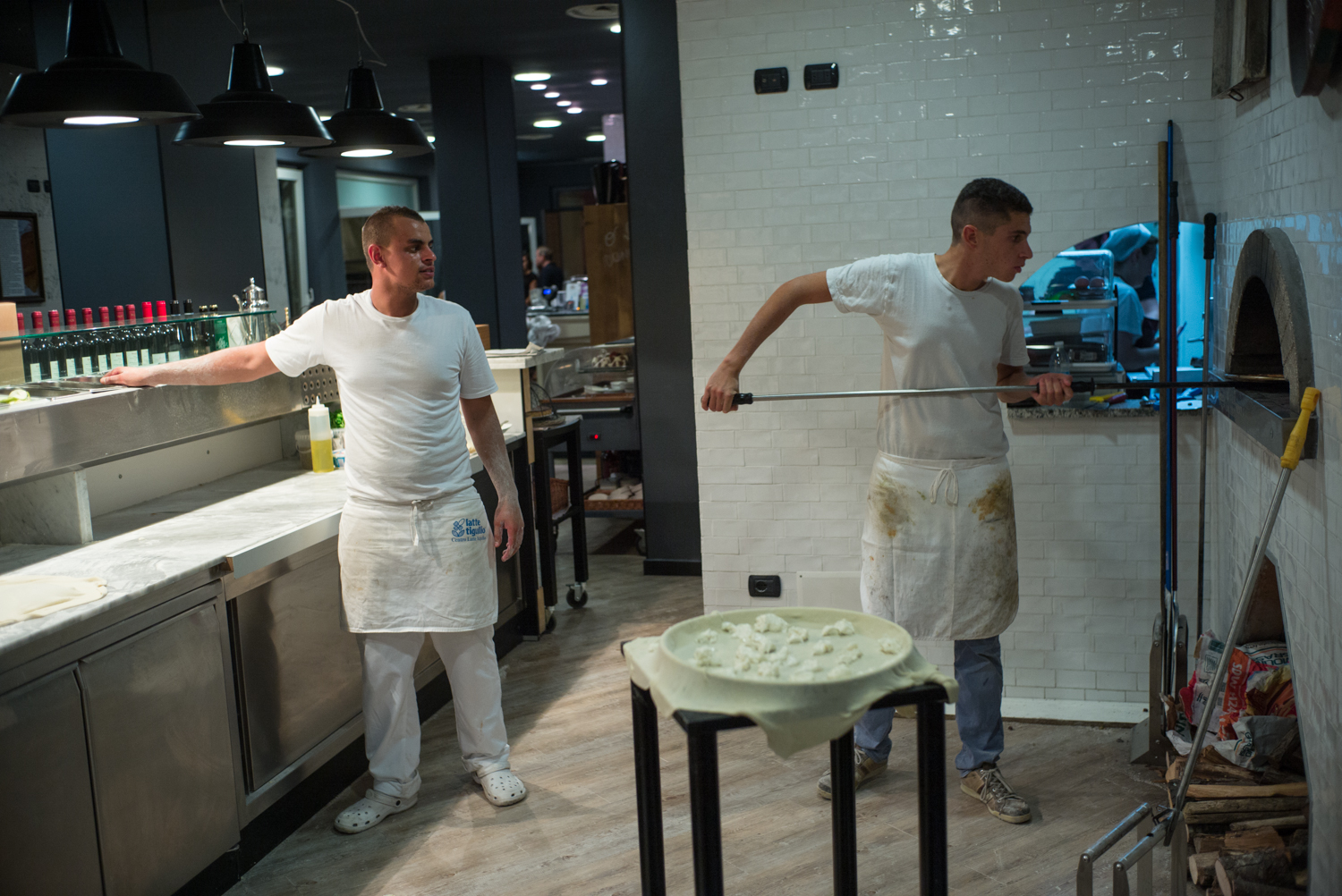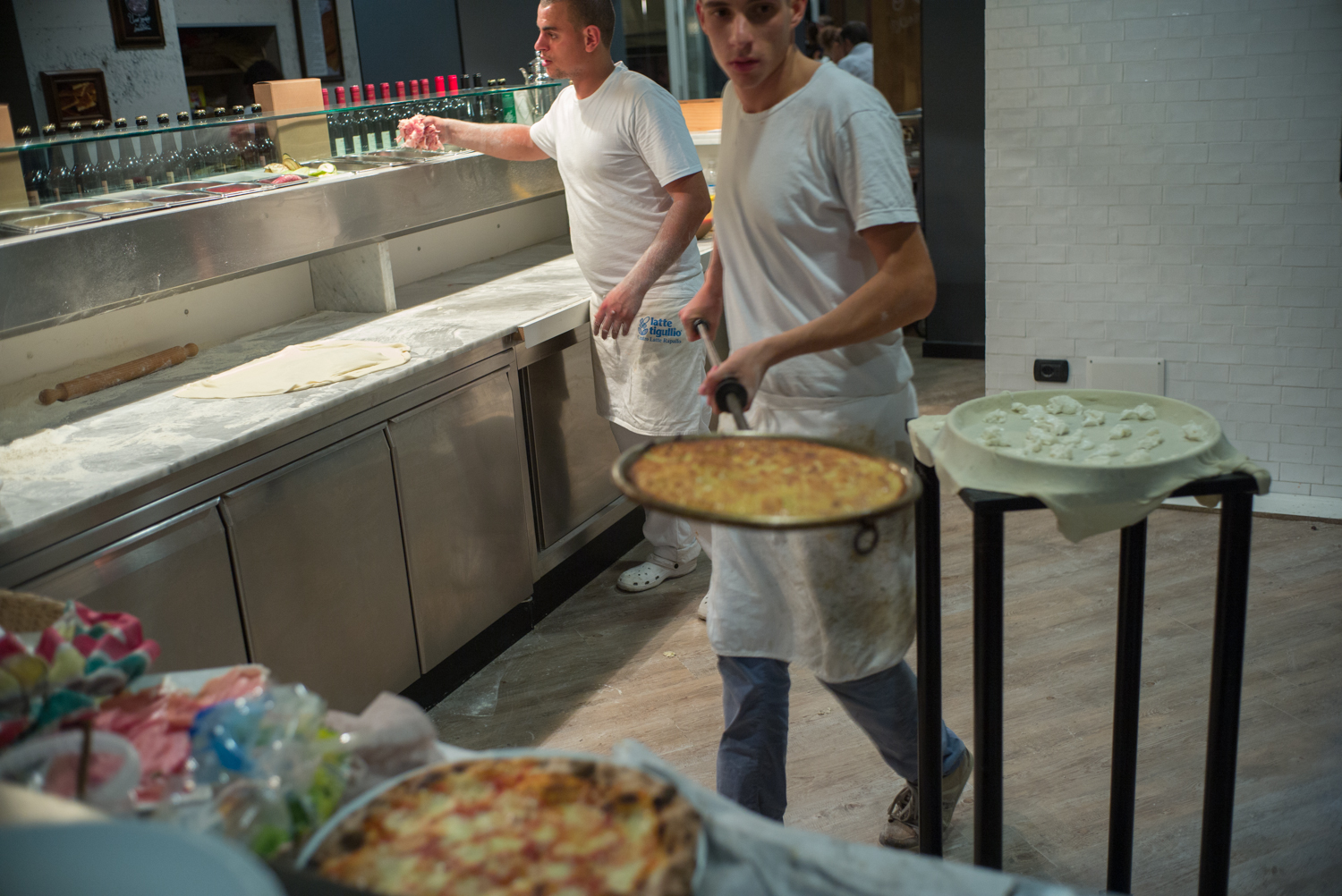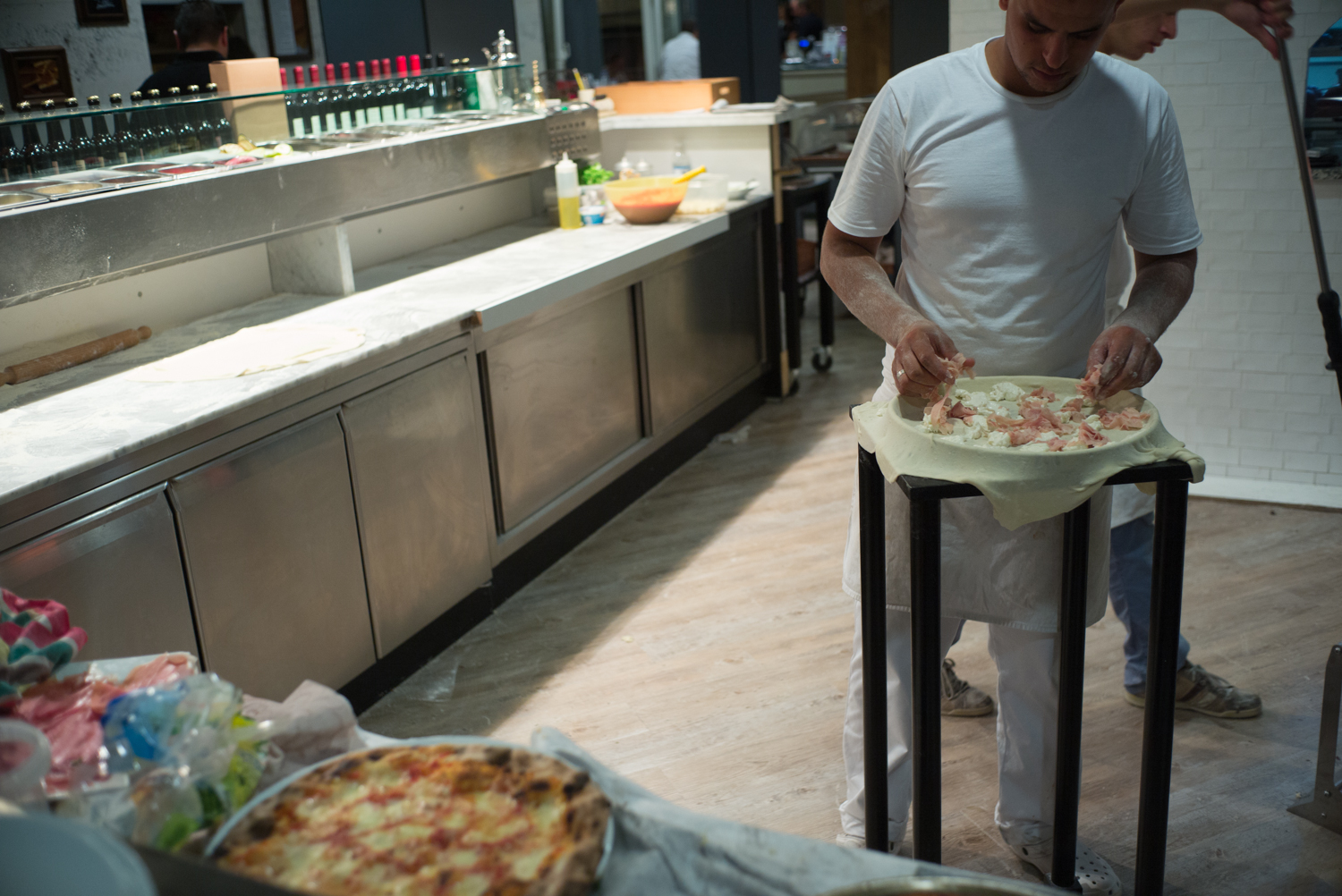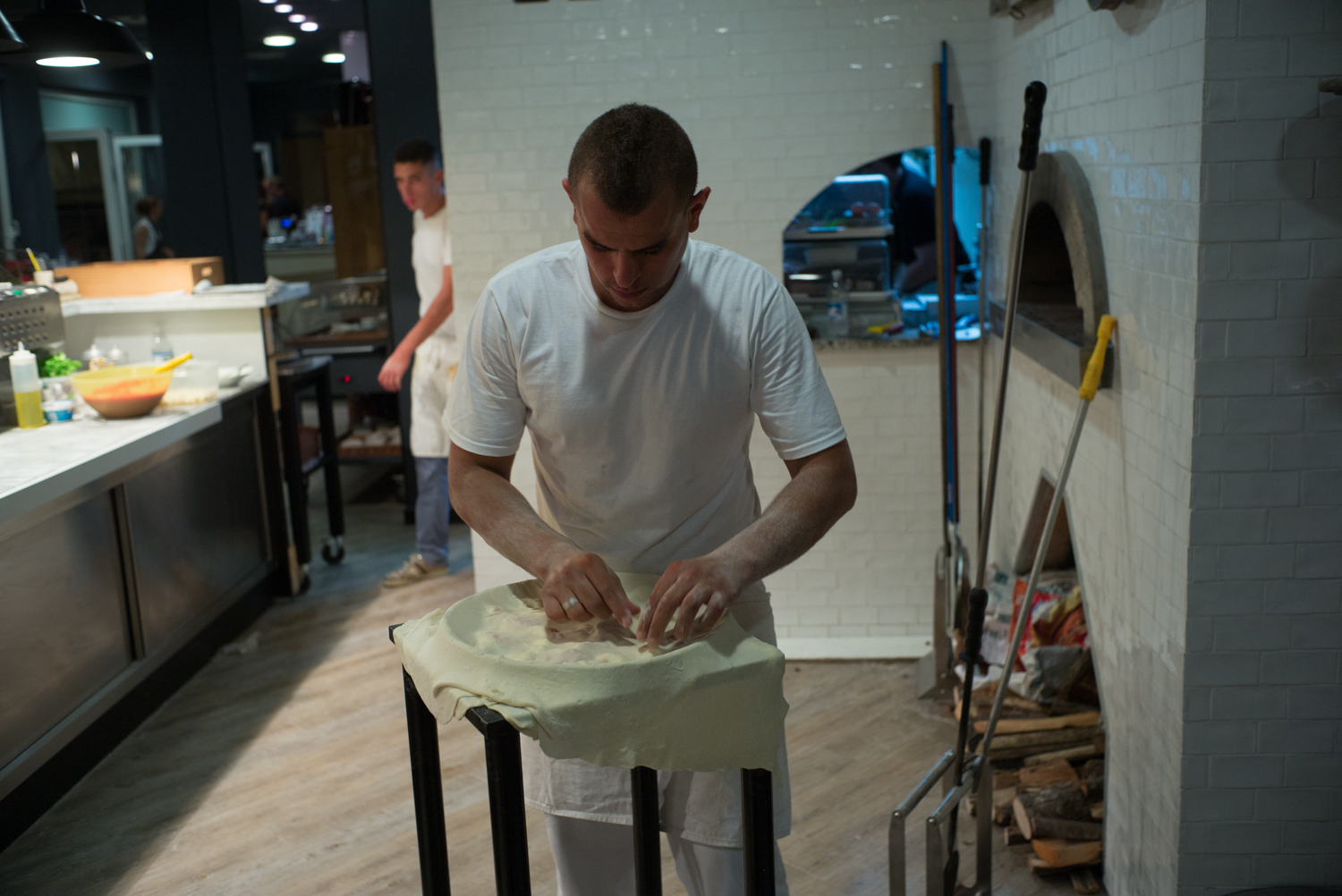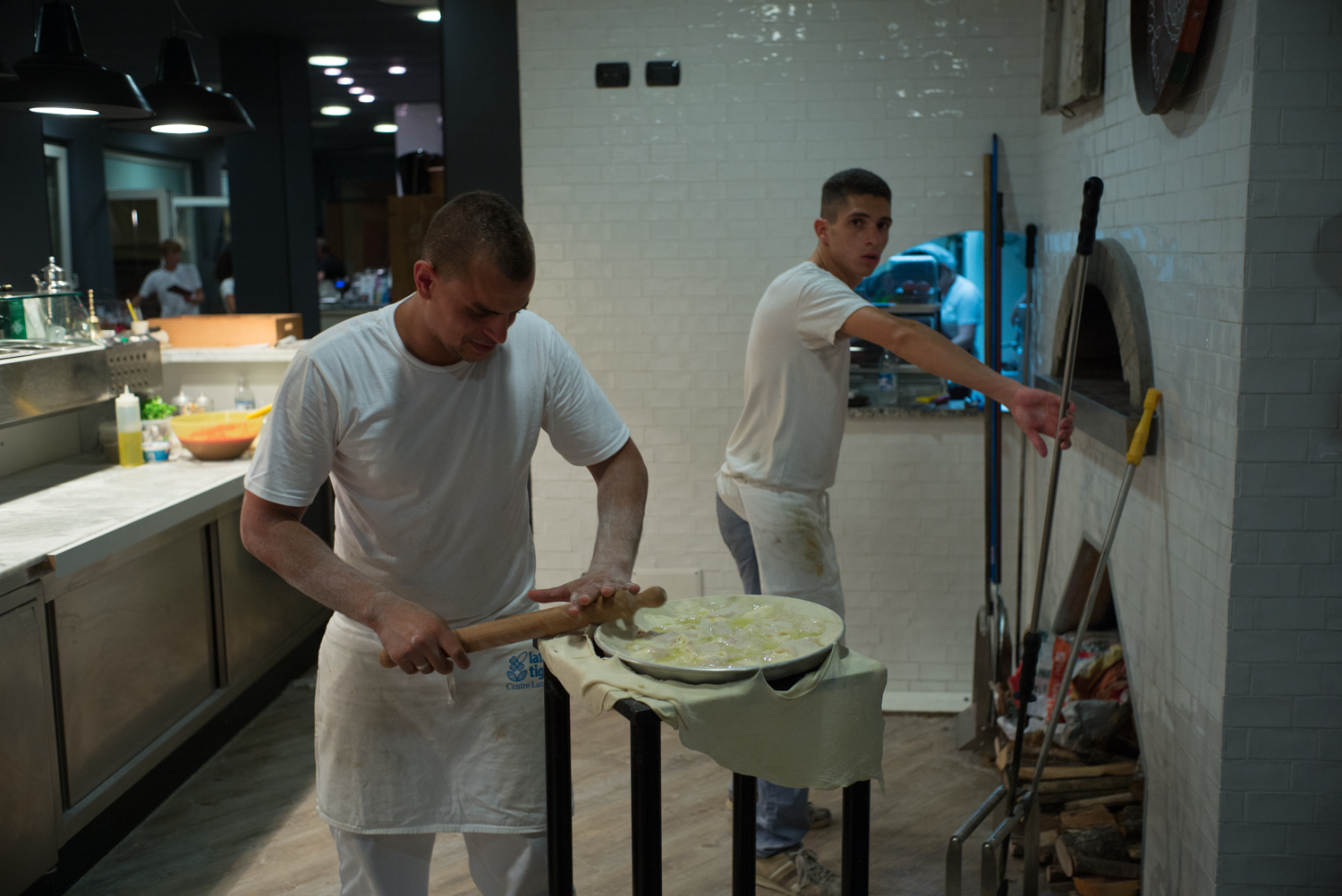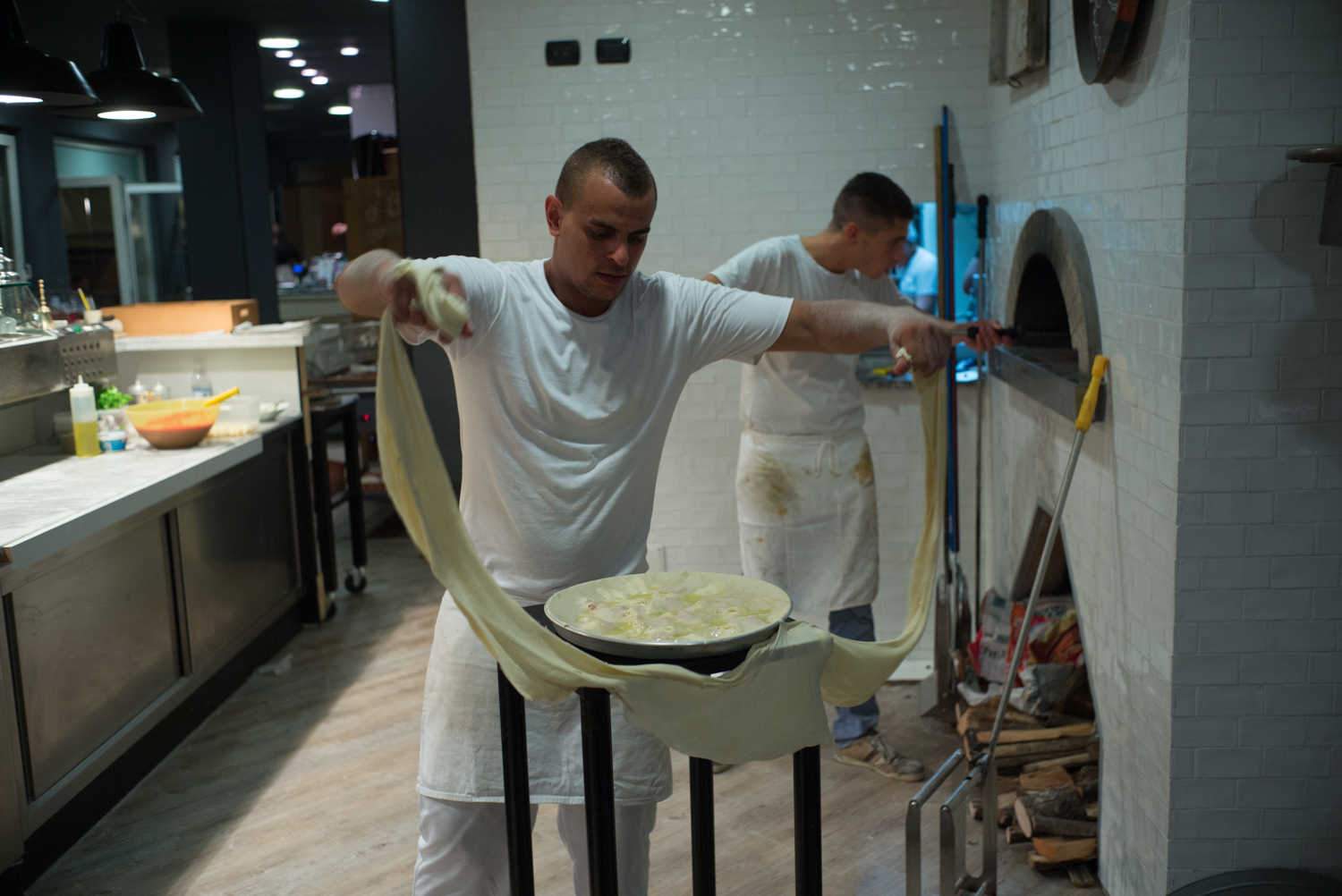Italy's Hidden {Pizza}
Focaccia di Recco prep at La Manuelina, in Recco.
I learned last summer, on the day when we had only an hour or two for a stop in Recco because we were on our way from one place in Italy to another, that one must eat focaccia di Recco (also known as focaccia col formaggio) straight out of the oven and not from an old pie that has already cooled to room temperature. This revelation occurred to me in the corner bakery located just next door to my first choice bakery that was, surprisingly, closed when we got there. But in Recco, a Riviera beach town that boasts none of the fanciness for which nearby places (such as Portofino) are known, focaccia di Recco (and farinata, another pizza proxy from the area) is on offer everywhere. Seriously, everywhere. It's a thing.
As I stood in that next door replacement-bakery (which is called Focaccia d’Autore) feigning conversation in Italian with the man in charge, who was happy to share with me details about *his* focaccia di Recco – like, which latteria does he get his stracchino from (he gave us each a spoonful to try) – I started to sense that the shop had become crowded behind me and grew concerned that I was holding things up for others.
The owner (or is he the manager?) of Focaccia d'Autore explains some of the pizza-like
things made in his shop. Click for detail of focaccia di Recco being made.
What if a hypothetical-Italian bakerygoer were to ask me why I was taking so long at the counter? Could I convincingly explain Pizzacentric, and that I consider this food a serious pizza proxy, and that it's virtually unknown outside of Liguria?
It turns out I need not have worried. Those other people were not waiting for me to finish talking so that they could order. They were waiting for a new (fresh and hot) focaccia di Recco to get pulled from the oven. I had ordered from the one they didn't want.
Focaccia di Recco, which is essentially two layers of thin unleavened dough surrounding an interior of an Italian melting cheese called stracchino, shares more characteristics with pizza than with other, more commonly known variations of focaccia: it's thin, not spongy; and when cooked becomes blistery — even crunchy in spots — with oozy cheese. However, unlike pizza or other focacce, when focaccia di Recco cools, it loses its overall crunch and the cheese loses its ooze.
The people behind me in the bakery knew this. Kristin had figured it out too – from watching those other people. I had no idea.
"I'll go back in and get a piece from the fresh one,” I said, after she had explained to me all of this.
Then Julia, who’s 8, chimed in: "Let's go, Daddy. Don't go back in!"
The beach in Recco.
I didn’t insist. Julia is not a fan of standing around waiting while I speak with restaurant owners. Also, there was one other focaccia di Recco lunch planned for the day – so I had to figure I'd be ok.
It took only a minute to walk to the beach, where we celebrated the warm salty air and the fact that we had finally made it to this area, which we had long discussed visiting but had not yet done.
Focaccia di Recco service at La Manuelina (Click for food close-up)
We finished eating and then drove about five minutes to arrive at place #2, La Manuelina, a swankish white tablecloth restaurant where one must order focaccia di Recco as a whole pie (there are size options) from suited-up waiters who slice and serve it from a tablecloth-laden side cart, kind of like they do Peking duck at fancier Chinese restaurants or how at retro old school places they still might make your Caesar tableside. In other words, it's a level of service not normally affiliated with the distribution of pieces of pizza. I love Italy.
Manuelina's focaccia di Recco, hot out of the oven, is undeniably exquisite. Go have it if you can.
**
We found focaccia di Recco on the menu in places in towns beyond Recco, including at Sciamadda in Moneglia. Scroll through slideshow for other "production" photos at Sciamadda, including Good place!
Perhaps a trip to Italy is not in the cards for you at this very moment and yet you are now craving focaccia di Recco in a big way. I understand. That was me last spring when I discovered this webpage while researching where to spend three unplanned days on our upcoming trip. Not only did the photos there directly influence our decision to choose Moneglia, a seaside town near Recco and near the famed Cinque Terre National Park, but they inspired me to make focaccia di Recco at home in New York, even prior to our travel.
The stracchino at Buon'Italia (rectangular packages). At $7.50 per 250g, it's not exactly cheap – you'll need 2 or 3, depending on the size of your pan – but it's a showstopper with dinner guests.
If you live in or are visiting New York, I discovered that you can purchase focaccia di Recco from the bakery counter at Eataly. But be warned: it’s not good. Unless you’re luckier than I’ve been, it will have been sitting out for a while, and will be soggy. I also question whether they pinch the top dough in spots before baking — which prevents interior steaming and creates a crispier top surface. Dunno. Maybe they do and it's just been out of the oven too long.
They also serve it at Rosemary’s, a lovely and good Italian restaurant on Greenwich Avenue in the Village. I haven’t tried it there. However, based on this picture, it looks yummy – but totally not correct. It appears thick (more like the focaccia most of us are used to) when it's supposed to be thin – I imagine they've used yeast.
Thus, if you can locate either stracchino (or crescenza, which works as a substitute), make focaccia di Recco yourself. I’ve done it. It’s not very difficult.
Before you begin, first locate and purchase the cheese, and then watch a few videos to see how it's done.
In New York, you can purchase stracchino at Buon’Italia, the excellent Italian food import store located in Chelsea Market. You can also find it at Eataly but it’s more expensive there. I have found crescenza in Carroll Gardens, Brooklyn, at Caputo’s Fine Foods.
First, watch the video posted on this page. It’s in English, and the guy does a good job demonstrating. However, the recipe he provides is a unclear in terms of how much flour to use – I prefer a weight measure (not volume) for flour. And he doesn’t use enough cheese (of course, that's easily remedied).
Next, watch the demo on this webpage. It’s in Italian, but it’s pretty easy to figure out what he’s doing. My only correction – yes, I'm apparently now more of an expert than this Italian dude – would be to leave it in the oven a minute or so longer :-).
And finally, watch this video from the Consorzio Focaccia di Recco col Formaggio (!) to see how these things are made large scale. Beautiful, right?
**
Recipe Focaccia di Recco (adopted from the Consorzio Focaccia col Formaggio di Recco)
Ingredients:
500 g (17.5 ounces) Caputo “00” (or all purpose) flour
2.75 dl (9.25 fluid ounces) room temperature water
0.5 dl (1.7 fluid ounces) top quality extra virgin olive oil + extra for the pan & for drizzling on top
15 g (1.5 teaspoons) fine sea salt + extra for sprinkling on top
750g stracchino (or crescenza)
One 25 cm x 35 cm (9.5” x 13”) sheet pan with raised edge
Process:
Mix together flour, water, olive oil, and salt to form a soft (but not sticky) dough. It should take about 2-3 minutes with mixer and dough hook, or about 4-5 minutes kneading by hand.
Form dough into a ball and wrap in plastic wrap. Allow it to rest at room temperature for at least 30 minutes (or up to 2 hours).
Preheat oven to its top temperature, at least 500 degrees F (260 degrees C).
Brush pan with a thin covering of extra virgin olive oil.
Unwrap dough, divide in half, and roll out to form a rectangular shape. Continue to roll out dough (or, if you’re comfortable hand-stretching — use your knuckles to gently stretch it, mindful of the ultimate shape you need it to be) until it will exceed the perimeter of your cooking pan.
Gently lay the stretched dough onto the pan and crimp it along the pan’s edges. Don’t worry if there’s extra dough, you’ll cut it off later.
Evenly distribute onto the stretched dough walnut-sized dots of the cheese in a grid pattern.
Stretch the second piece of dough, following the same strategy as the first. Cover the dough and cheese with the stretched second dough, crimping it along the pan’s edges to make a seal. You will notice that there are air pockets between the two layers of dough, wherever there isn’t cheese: this is good.
Use rolling pin or pizza cutter to remove excess dough by rolling it across the top of the pan’s rim. Pinch and tear at the top dough in 4-6 spots. Drizzle top with extra virgin olive oil (best quality) and sprinkle with fine sea salt.
Bake in oven for 4-8 minutes. Focaccia is done when top is nicely browned in several spots but not burnt.
Remove focaccia from the oven. Slide onto a cutting board or leave in pan. Slice and consume immediately.
**
Notes:
1. Recipe is geared toward inexperienced pizza/focaccia makers. If you’re confident in your rolling-out skills, you can use a somewhat larger pan.
2. I always end up with extra dough, so recipe may be enough for two focacce (or 1 + a second at half-sheet size) if you have enough cheese on hand. Roll it out thin like the pictures/videos, don't be stingy with the cheese, and see what's left.
2. If you can’t find stracchino or crescenza, you could attempt recipe with other cheese types that has a similar meltability – something like ricotta or a mild brie would work. Choose based on your taste preference but if possible, avoid strong tasting cheeses since they could overpower the flavor of the good olive oil.
3. Focaccia di Recco is, apparently, a pretty old food. According to the foodtravel.it website, it's been around since at least the 12th century.
**
In Italy:
Focaccia d'Autore: Via Assereto Biagio 11, Recco (+39 0185 76610).
Ristorante La Manuelina: Via Roma, 278, Recco (+39 0185 74128). Open Thursday - Tuesday (closed Wednesday) 12pm-2:30pm and 7:30pm-10:30pm. Website. La Manuelina also operates a more casual-looking focacceria; it's only open for dinner, I didn't go there.
In New York (for stracchino):
Buon'Italia: 75 9th Avenue (in Chelsea Market), New York (212-633-9090). Open Monday - Saturday 8am-9pm, Sunday 9am-7pm.




